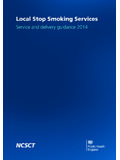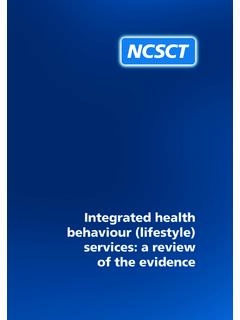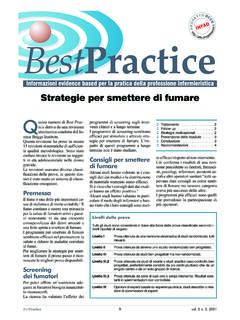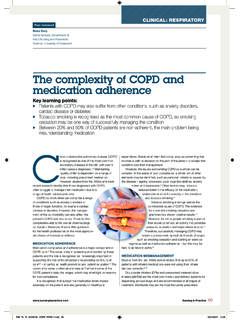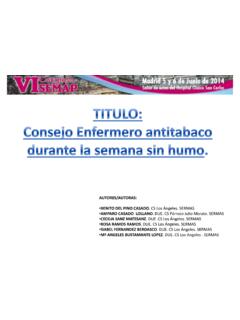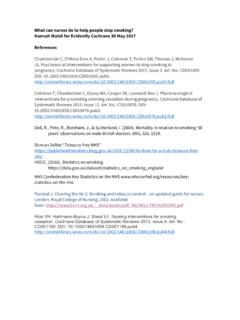Transcription of Rice VH, Stead LF - NCSCT
1 Nursing interventions for smoking cessation (Review) rice VH, Stead LFThis is a reprint of a Cochrane review, prepared and maintained by The Cochrane Collaboration and published inThe Cochrane Library2009, Issue 1 interventions for smoking cessation (Review)Copyright 2009 The Cochrane Collaboration. Published by John Wiley & Sons, A B L E O F C O N T E N T S1 HEADER ..1 ABSTRACT ..2 PLAIN LANGUAGE SUMMARY ..2 BACKGROUND ..2 OBJECTIVES ..3 METHODS ..7 RESULTS ..11 DISCUSSION ..13 AUTHORS CONCLUSIONS ..13 ACKNOWLEDGEMENTS ..13 REFERENCES ..18 CHARACTERISTICS OF STUDIES ..46 DATA AND ANALYSES ..Analysis Comparison 1 All nursing intervention vs control trials, grouped by intensity of intervention, Outcome 1 Smoking cessation at longest follow up..48 Analysis Comparison 2 All nursing intervention vs control trials, grouped by setting and population, Outcome 1 Smoking cessation at longest follow up.
2 50 Analysis Comparison 3 Effect of additional strategies:Higher versus lower intensity, Outcome 1 Additional componentsat single contact. Smoking cessation at longest follow up..52 Analysis Comparison 3 Effect of additional strategies:Higher versus lower intensity, Outcome 2 Additional cessation at longest follow up..53 Analysis Comparison 4 Sensitivity analysis by intensity, including Hajek 2002, with Lancaster, Bolman, Curry as lowintensity, Outcome 1 Smoking cessation at longest follow up..54 Analysis Comparison 5 Sensitivity analysis by settingand population, including Hajek 2002, Outcome 1 Smokingcessation at longest follow up..5656 WHAT S NEW ..56 HISTORY ..57 CONTRIBUTIONS OF AUTHORS ..57 DECLARATIONS OF INTEREST ..57 SOURCES OF SUPPORT ..57 INDEX TERMS ..iNursing interventions for smoking cessation (Review)Copyright 2009 The Cochrane Collaboration.
3 Published by John Wiley & Sons, Ltd.[Intervention Review]Nursing interventions for smoking cessationVirginia Hill Rice1, Lindsay F Stead21 College of Nursing, Wayne State University, Detroit, Michigan, of Primary Health Care, University of Oxford,Oxford, UKContact address: Virginia Hill rice , College of Nursing, Wayne State University, 5557 Cass Avenue, Detroit, Michigan, 48202, group:Cochrane Tobacco Addiction status and date:Edited (no change to conclusions), published in Issue 1, content assessed as up-to-date:20 October : rice VH, Stead LF. Nursing interventions for smoking Database of Systematic Reviews2008, Issue 1. : CD001188. DOI: 2009 The Cochrane Collaboration. Published by John Wiley & Sons, B S T R A C TBackgroundHealthcare professionals, including nurses, frequently advise patients to improve their health by stopping smoking.
4 Such advice maybe brief, or part of more intensive determine the effectiveness of nursing-delivered smokingcessation strategyWe searched the Cochrane Tobacco Addiction Group specialized register and CINAHL in July criteriaRandomized trials of smoking cessation interventions delivered by nurses or health visitors with follow up of at least six collection and analysisTwo authors extracted data independently. The main outcome measure was abstinence from smoking after at least six months offollowup. We used the most rigorous definition of abstinence for each trial, and biochemically validated rates if available. Where statisticallyand clinically appropriate, we pooled studies using a Mantel-Haenszel fixed effect model and reported the outcome as a risk ratio (RR)with 95% confidence interval (CI).Main resultsForty-two studies met the inclusion criteria.
5 Thirty-one studies comparing a nursing intervention to a control or to usual carefoundthe intervention to significantly increase the likelihood of quitting (RR , 95% CI to ). There was heterogeneityamongthe study results, but pooling using a random effects model did not alter the estimate of a statistically significant effect. In a subgroupanalysis there was weaker evidence that lower intensity interventions were effective (RR , 95% CI to ). There was limitedindirect evidence that interventions were more effective for hospital inpatients with cardiovascular disease than for inpatients withother conditions. Interventions in non-hospitalized patients also showed evidence of benefit. Nine studies comparing different nurse-delivered interventions failed to detect significant benefit from using additional components. Five studies of nurse counselling onsmoking cessation during a screening health check, or as part of multifactorial secondary prevention in general practice (not includedin the main meta-analysis) found nursing intervention to have less effect under these interventions for smoking cessation (Review)Copyright 2009 The Cochrane Collaboration.
6 Published by John Wiley & Sons, conclusionsThe results indicate the potential benefits of smoking cessation advice and/or counselling given by nurses to patients, withreasonableevidence that intervention is effective. The evidence of an effect is weaker when interventions are brief and are provided bynurseswhose main role is not health promotion or smoking challenge will be to incorporate smoking behaviour monitoringand smoking cessation interventions as part of standard practice, so that all patients are given an opportunity to be asked about theirtobacco use and to be given advice and/or counselling to quit along with reinforcement and follow L A I N L A N G U A G E S U M M A R YDoes support and intervention from nurses help people to stop smokingMost smokers want to quit, and may be helped by advice and support from healthcare professionals.
7 Nurses are the largest healthcareworkforce, and are involved in virtually all levels of healthcare. This review of clinical trials covered 42 studies, with more than 15,000participants included in the analyses. It found that advice andsupport from nursing staff could increase people s success in quittingsmoking, especially in a hospital setting. Similar advice andencouragement given by nurses at health checks or prevention activitiesseems to be less effective, but may still have some A C K G R O U N DTobacco-related deaths and disabilities are on the increase world-wide, because of continued use of tobacco (mainly cigarettes). To-bacco use has reached epidemic proportions in many developingcountries, while steady use continues in industrialized nations (Davis 2007;West 2006;DHHS 2004). The following two factorsmay help to reduce the prevalence of cigarette smoking: (1) 79%to 90% (Coultas 1991) of smokers want to quit smoking (NIH2006) and (2) 70% of smokers visit a healthcare professional eachyear (Cherry 2003).
8 Nurses, with the largest number of healthcareproviders worldwide, are involved in the majority of these visitsand could therefore have a profound effect on the reduction oftobacco use (Percival 2003;Whyte 2003).Systematic reviews ( 2004) have confirmed the effec-tiveness of advice to stop smoking from physicians. The Agencyfor Health Care Research and Quality Clinical Practice Guideline(AHRQ 2000) notes strong support for physicians to advise ev-ery patient who smokes to quit. The findings for advice by non-physician clinicians have been weaker, although the guidelinerec-ommends that all clinicians provide interventions. A review ofnursing s role in smoking cessation is essential if the profession isto endorse the American Nurses Association position, ..patienteducation and preventive healthcare interventions to stop tobaccouse should be part of nursing practice (ANA 1995).
9 The aim of this review is to examine and summarize randomizedclinical trials where nursing provided smoking cessation interven-tions. The review therefore focuses on the nurse as the interventionprovider, rather than on a particular type of intervention. Smok-ing cessation targeting pregnant women are not included here,be-cause of the particular circumstance and motivation among thesewomen. Interventions for pregnant smokers have been reviewedelsewhere (Lumley 2004).O B J E C T I V E SThe primary objective of this review was to determine the effec-tiveness of nursing-delivered interventions on smoking behaviourin prioristudy hypotheses were that nursing-deliveredsmoking cessation interventions:(i) are more effective than no intervention(ii) are more effective if the intervention is more intense(iii) differ in effectiveness with health state and setting ofthe par-ticipants(iv) are more effective if they include follow ups(v) are more effective if they include aids that demonstrate thepathophysiological effect of smoking2 Nursing interventions for smoking cessation (Review)Copyright 2009 The Cochrane Collaboration.
10 Published by John Wiley & Sons, review does not address the incremental effects of provid-ing nicotine replacement therapy (NRT) by nurses, as NRT effec-tiveness is addressed in a separate Cochrane review ( Stead 2008).Studies in which advice about nicotine replacement was part ofthe nursing intervention are E T H O D SCriteria for considering studies for this reviewTypes of studiesInclusion criteria for studies were:(i) they had to have at least two treatment groups(ii) allocation to treatment groups must have been stated to be random Studies that used historical controls were of participantsParticipants were adult smokers, 18 years and older, of either gen-der and recruited in any type of healthcare setting. The only excep-tions were studies that had exclusively recruited pregnant in which recent quitters were classified as smokers wereincluded, but sensitivity analyses were performed to determinewhether they differed from trials that excluded such of interventionsNursing intervention was defined as the provision of advice, coun-selling, and/or strategies to help patients quit smoking.
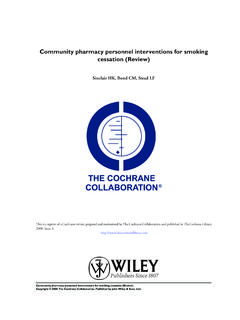

![e-cigarettes briefing [ 2 ] v4 - NCSCT](/cache/preview/0/6/5/c/9/3/f/f/thumb-065c93ffb7496a6f7f874369520a6a6d.jpg)



